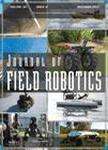版权所有:内蒙古大学图书馆 技术提供:维普资讯• 智图
内蒙古自治区呼和浩特市赛罕区大学西街235号 邮编: 010021

作者机构:Univ Sheffield Dept Automat Control & Syst Engn Sheffield England
出 版 物:《JOURNAL OF FIELD ROBOTICS》 (J. Field. Rob.)
年 卷 期:2025年第42卷第3期
页 面:806-826页
核心收录:
学科分类:12[管理学] 1201[管理学-管理科学与工程(可授管理学、工学学位)] 08[工学] 0811[工学-控制科学与工程]
基 金:This work is supported by Engineering and Physical Sciences Research Council grant EP/S016813/1 Pervasive Sensing for Buried Pipes (Pipebots). [EP/S016813/1] Engineering and Physical Sciences Research Council Engineering and Physical Sciences Research Council [EP/S016813/1] Funding Source: researchfish
主 题:field robotics localization mobile robots navigation
摘 要:Accurate, reliable, and efficient robot localization is essential for long-term autonomous robotic inspection of buried pipe networks. It is necessary for path planning and for locating detected faults in the network. This paper proposes a novel localization algorithm designed for limited, high-uncertainty sensing in network environments. The localization method is developed from the Viterbi algorithm, which efficiently searches for the most likely robot trajectory amongst multiple hypotheses. It is augmented to facilitate hybrid metric-topological localization, and it is improved to efficiently spend computation on useful points in time. Results using field robot data from a sewer network demonstrate the algorithm s practical applicability, as the algorithm is shown to robustly produce a coherent trajectory estimate with low error in estimated location, compared with a particle filter alternative that incorrectly jumps between parts of the network. Results using simulated data demonstrate the algorithm s robust performance at large spatial and temporal scales. In 79% of trajectories, the algorithm produces less error than a particle filter, while requiring a median of 0.18 times the computation time, demonstrating a substantial improvement in computational efficiency with comparable or superior accuracy. The flexibility of the algorithm is also demonstrated in simulation by incorporating measurements representing acoustic echo sensing and pipe gradient sensing, which is shown to reduce the error rate from 28% to 7% or below, in the case of large uncertainty in all other inputs. These results demonstrate that the proposed localization method improves the computational efficiency, accuracy, and robustness of localization compared to a particle filter specialized to the pipe environment, even in the presence of limited and high-uncertainty sensing.